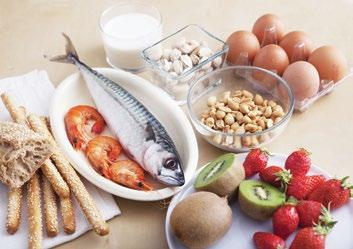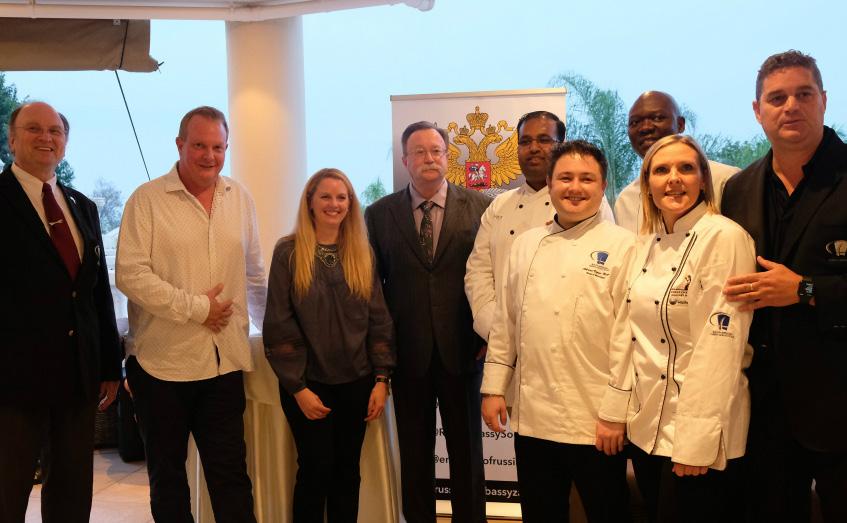
14 minute read
FACTS
ALL IMAGES COURTESY OF UNSPLASH
AN UMBRELLA VIEW OF THE PLANT-BASED MOVEMENT
Advertisement
The rapidly growing plant-based trend offers opportunities for the hospitality and restaurant trade; however, some attention needs to be paid to understanding the regulatory framework and meal preparation challenges. Food and Allergy Consulting and Testing Services (FACTS SA) share their insights.
THE MOVE TO PLANT-BASED MEALS There has been a clear increase in consumer interest in plant-based products and meal options, and it is expected that this interest will grow steadily in the foreseeable future. This growing movement presents opportunities and challenges for the food and hospitality industry – some of those challenges being identified in the area of preparation practices.
The unintentional addition, during preparation, or deliberate addition (in terms of adulteration at supplier level) of animal materials to food can lead to two major problems: the presence of undeclared animal species; and more specifically, food claimed to be suitable for vegans – and to an extent, vegetarians – containing animal substances.
To address these problems as separate entities and thus reduce the different risks involved, it is necessary to take a step back and gain perspective – a view from above of how the picture fits together.
ANIMAL SPECIES CONTROL Species control includes the identification and control of animal substances to prevent the presence of undeclared animal species in food at every stage of the preparation process, from harvesting through to presenting and packaging the meals.
The addition of undeclared meat species to food and meat products is not an uncommon occurrence. In South Africa, in recent years, multiple incidents of species substitution and mislabelling of meat and fish products have been recorded. Occurrences of this nature not only constitute consumer fraud, violate religious faiths and raise ethical concerns, but can result in food safety risks.
Intentional presence of undeclared animal species
Due to their high cost, food products such as meat and fish are highly prone to substitution or adulteration, and such practices are often relatively simple to get away with. The flesh of many meat and fish species differs only subtly in appearance and texture, making it difficult to identify the species used by visual inspection only. Another type of substitution of meat ingredients involves the use of cheaper ingredients from the same declared species, but from different body parts (typically offal, connective tissue, or blood);
or the substitutes may be nonmeat ingredients (e.g. from plant or dairy sources). The fisheries and aquaculture sector is also considered particularly vulnerable to food fraud. As a result of the rising incidence of food fraud in the food manufacturing environment, food certification programmes now require that these types of vulnerabilities are controlled with VACCP (Vulnerability Assessment Critical Control Points) in addition to HACCP (Hazard Analysis Critical Control Points).
The unintentional addition or substitution of species may be due to a lack of expertise, management and/or control. A significant concern is the potential for meat products to be contaminated by undeclared species during the preparation of meals. Cross-contamination can arise when poorly cleaned equipment or utensils are used when preparing meat from two or more different meat species, or when preparing a plant-based meal. To date, South Africa has not set any threshold levels for undeclared animal species. However, studies have shown that a proper cleaning plan is key to mitigating cross-contamination.
WHAT DO THE REGULATIONS SAY? The Regulations relating to the Labelling and Advertising of Foodstuffs (R.146/2010) define vegetarian-based statements that can be used on pre-packed food. Although not directly applicable to meals served in the hospitality industry, they are important to consider, as they are what FACTS banner 203x32 9/18/20 3:52 PM Page 1 consumers are exposed to and are used to seeing on food labels.
The term ‘vegetarian’ may not be used as a blanket statement on a specific food. The type of vegetarian is required to be specified by adding the appropriate prefix, e.g. ‘Lacto (milk) vegetarian’ for products containing milk products, though products in which animal rennet is used during preparation are excluded; ‘Ovo (egg) vegetarian’ means unfertilised eggs (preferably freerange) and egg products are included, and ‘Honey vegetarian’ means honey is included. ‘Strict vegetarian’ or ‘vegan’ is reserved for products containing no ingredients or additives derived from animal origins at all.
Note that ingredients of multicellular plant, fungal, algal and bacterial origin are included; but all animal flesh and products obtained from the slaughter of an animal – such as gelatine, animal fats, caviar and roe – are excluded.


Directly applicable regulations:
The following two Acts are directly applicable to the hospitality industry, and clearly state that it is
C M Y CM MY a criminal offence if a food is sold as something that it is not (e.g. making a false plant-based claim): • The Foodstuffs, Cosmetics and
Disinfectants Act (Act No. 54 of 1972), which prohibits the sale and manufacture of any food which contains or has been treated with a substance not normally present in that food; or if a substance has been added to increase the mass or volume of the food with the intention to deceive. • The Consumer Protection Act (Act 68 of 2008) (CPA) was enacted (among other reasons) to protect consumers from hazards to their well-being and safety, and to set out consumers’ rights to safe, good-quality goods. The CPA also prohibits direct or indirect marketing to the consumer of goods if the marketing implies a false, misleading or deceptive misrepresentation concerning a material fact.
This regulation includes monetary penalties that could be costly to your business.
CY CMY K
Regulatory exclusions and pitfalls
R.146 does not address the following: • How to manage potential cross-contamination from non-vegetarian products to vegetarian products; • Animal material processing aids being used unknowingly; • Control strategies for the preparation processes of meals; and perhaps most importantly, • The allergen precautionary (warning) labelling required on vegetarian products.
A comprehensive regulatory framework results in a situation in which the supply chain comprehends that it must comply; and consumers can then trust the products provided. The current lack of criteria for the use of vegetarianrelated terms in food labelling and preparation may result in complications, including – but not limited to – the following:
Food Safety
In South Africa, four of the eight regulated common food allergens are of animal origin, namely cow’s milk, egg, fish and shellfish. A vegan/vegetarian claim, to the consumer, suggests that a product contains no animal products or by-products, and therefore creates the risk that an allergic consumer could be misled into assuming that the product is safe for consumption. There is an evident risk to allergic consumers who treat ‘vegan’ claims and allergen absence claims (e.g. ‘milkfree’) as equivalent; this could have serious health implications.
Although allergen precautionary labelling (specifically related to food allergens associated with animal products) is allowed on a product that is classified or claimed to be suitable for vegans and vegetarians, there is a risk for consumers, particularly those dining out, to assume that their meal does not contain any traces of animal substances.
Ethical concerns
Consumers must be protected not only from a food safety perspective, but also from an ethical standpoint. This is not a problem exclusive to vegetarians; it also affects religious classifications such as Halal, Kosher, etc. Vegetarianbased lifestyles are frequently driven by strong ethical concerns, and products suitable for these diets often come at a premium price. Ensuring that consumers are not exploited, whether financially or morally, is essential.
Food suppliers and consumer assurance
The hospitality and restaurant industry has a responsibility to ensure safe meals are prepared and served; failing to do so can have a direct effect on a business’s reputation. Ensuring brand assurance requires that the entire supply chain is confident in its product integrity. Unfortunately, the current lack of criteria can result in compromised brand assurance.
A programme to consolidate the numerous aspects of risk involved must include compliance with food and consumer legislation, along with ensuring that ingredients received are safe.

Testing
Testing is commonly used in the food industry to validate and substantiate a labelling claim, such as when a meal is claimed to be free from a certain allergen, or when a nutrient-content claim such as ‘fat-free’ or ‘high in protein’ is used to describe a meal. The exclusion of regulatory stipulations for vegan claims has left the food industry in the dark concerning analysis requirements. This leads to many undesired outcomes, often resulting in an uneven playing field.
As the various aspects of veganism are unique and multifactorial, and as there is no specific ‘vegan foodstuff test’ on the market, it may seem like an impossible task to determine how to go about this matter.
A SOUTH AFRICAN MARKET VIEWPOINT The South African vegan directory provided by Vegan SA has the following requirements regarding vegan products:
To qualify to be listed on their site as a vegan foodstuff, a product must be: • Free of animal products, and use only ingredients that contain no animal products. • Free of animal testing, and use only ingredients that have not been tested on animals, whether at the initiative of the manufacturer or on its behalf, or by parties over whom the manufacturer has effective control. • Products that contain or may contain any genetically modified organisms (GMOs) must be labelled as such.
Vegan SA go on to include these details for the food manufacturing environment: if a product is manufactured on the same production line used to manufacture food that does contain animal products, then the manufacturer must make the following commitment:
‘We confirm that our company minimises cross-contamination from animal substances used in other (non-vegan) products as far as is reasonably practicable.’
In addition to this, they also have set criteria regarding veganfriendly eateries and dining-out establishments in South Africa that are suitable for vegans.
To qualify for a listing on their site as a vegan-friendly restaurant, an eatery must have the following vegan options: • 3 starters and 3 main courses on its menu (can include 1 salad each course); or • For dining options that are not on the menu - 1 starter and 1 main course that are changed daily.

To qualify for a listing as a veganfriendly fast food outlet, an establishment must have the following vegan options: • 3 main courses on its menu (can include 1 salad); or • For dining options that are not on the menu - 1 main course that is changed daily.
AT GRASS ROOTS Food adulteration and food authenticity failures can be driven by pressures on food production and lack of regulatory guidance and enforcement, as well as the current climate of financial constraint. This has become even more evident with the increasing popularity of plant-based lifestyles and sustainability movements.
A change in consumer trends, science, environment or technology – and consequently, food industry movement – is usually the catalyst for regulatory alterations and adaptions. Legislation must respond to these changes to ensure that attention is paid to situations in which serious food risks could occur, and ultimately secure consumer protection. The rise in consumer sustainability movements has revealed potential shortfalls in the current labelling and preparation requirements for plant-based foods.
To prevent any future problems, the legislation must address these gaps. Despite the current absence of regulatory guidance in terms of vegetarian and vegan food and species control, it is still the food industry’s responsibility to ensure product authenticity and consumer protection; by employing and implementing good practices and comprehensive controls throughout the supply chain, while adhering strictly to established regulatory requirements such as allergen control.


CONTACT FACTS SA To access assistance with regulatory, testing and other related services in the food sector, please email info@factssa.com or visit www.facstsa.com for more information.
HTA CROWNS WINNERS OF LEGACY COMPETITION

The HTA School of Culinary Art Legacy Young Chef Competition 2020 took place on 19 September to great fanfare with 10 talented finalists and 6 judges.
Now in its fifth year, the HTA School of Culinary Art Legacy Young Chef Competition was first held in 2016. The competition was created to inspire the minds of young South African Chefs as HTA Students. It also allows the students to showcase their skills and impart the latest culinary trends and further test themselves against the challenges of their chosen career.
Ten Full-Time SecondYear Students were selected through trials to take part in this prestigious competition. The finalists were: • Anastasia Geldenhuys • Cobus Muller • Craig Morgan • Daphney Kanotsauka • Emile Wienand • Jordan Blain • Karabo Phiri • Keenan Denoon • Tyler van der Westhuizen • Zaydaan Laly
The main objective of the competition, other than that of the educational and fun component offered through competitions, is to expose our students, the next generation of industry leaders, to a wide range of quality products and ingredients and to allow them to incorporate them into 5 Star Cuisine.
The competition was followed by a cocktail event and was attended by approximately 50 influential industry members, family members as well as the sponsors.
SELECTION OF FINALISTS The finalists are full-time based students who are about to complete their final year in the Two-Year Full-

Time Culinary Arts Programme at HTA. They were chosen as semifinalists for this competition based on their overall performance and marks practically and theoretically over a total of 2 years. Following a cook-off held in August at HTA, the ten finalists were selected.
JUDGING PANEL The panel comprised of Executive Chefs from leading establishments, hospitality industry experts and last years’ winner of the Legacy Competition.
Guest judges were: Chef Kabelo Segone; Chef Arnold Tanzer; Chef Stuart Mc Clarty; Chef Fungai Muzorewa; Chef Kirsten Jane Howell; Chef Hector Mnyayiza; and Chef Devon Holman.
HTA School of Culinary Art thanks them for their contribution to this prestigious event.
COCKTAIL EVENT AND WINNER ANNOUNCEMENT Each finalist was awarded with a Legacy Competition Hamper filled with various amazing prizes from the contributing Sponsors. Each finalist was also given an HTA School of Culinary Art Legacy embroidered Chef Uniform.
The winner of the 2020 competition was Tyler van der Westhuizen, with Zaydaan Laly taking second position, and Karabo Phiri in third place.
SOME MUCH-NEEDED POSITIVITY The event was a great success this year and much needed positivity after a stressful year. It was well supported and the media coverage will no doubt assist in achieving our goals, namely: • Embrace and celebrate the talent of home grown young
South African Chefs • To allow young South
African Chefs to put their skills to the test • Assist young South African Chefs in profiling themselves and our industry To produce quality food under immense pressure Provide media coverage for HTA School of Culinary Art
In conclusion, the annual HTA School of Culinary Art Legacy Competition, has already established itself on South Africa’s Culinary Calendar and we look forward to hosting the competition for the 6th time next year.
Thank you to all the sponsors and industry guests for your help in making this year’s event a success.
For more info on HTA, visit www.htatrain.co.za.


THE CHEFS WITH COMPASSION CORE TEAM WITH THE RUSSIAN AMBASSADOR AND SA CHEFS
CWC RECEIVES DONATION FROM RUSSIAN AUCTION
The Russian Embassy in Pretoria donate the proceeds from their charity auction to Chefs with Compassion to assist in the significant work they are doing.
Ambassador of Russia to South Africa, H.E.Mr.Ilya Rogachev, handed over to the representative of the Chefs with Compassion NGO, Chef Coo Pillay, the proceeds from the charity auction purposed to deliver food assistance to socially vulnerable population groups in South Africa.
The auspicious handover took place on 6 October 2020, with proceeds gathered from an online charity auction arranged by the Russian Embassy. Among the lots were books, photographs and souvenirs provided by the Embassy staff.
Head of Russian diplomatic mission in Pretoria extended his gratitude to all the contributors to the charity auction: “The experience has proven that not a single country or organisation facing the coronavirus pandemic can overcome this threat on their own. In these difficult times we must help each other and stay together.”
The charity auction was attended by the representatives of the Department of International Relations and Cooperation of South Africa, Bryanston Auctioneers - who also hosted the auction - as well as South African media and Russian nationals residing in South Africa.
Chefs with Compassion recently reached an incredible milestone of providing over 1 million meals to those most affected by the COVID-19 crisis in Gauteng. Congratulations to the team who have recently also announced that they will be comtinuing this initiative into the new year for as long as they are able after the lockdown comes to an end.










